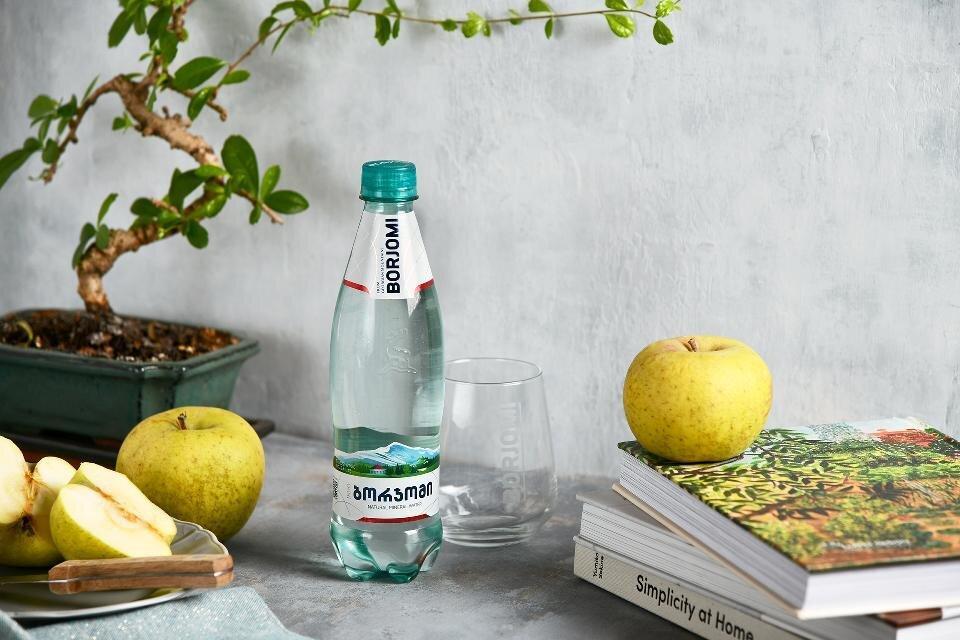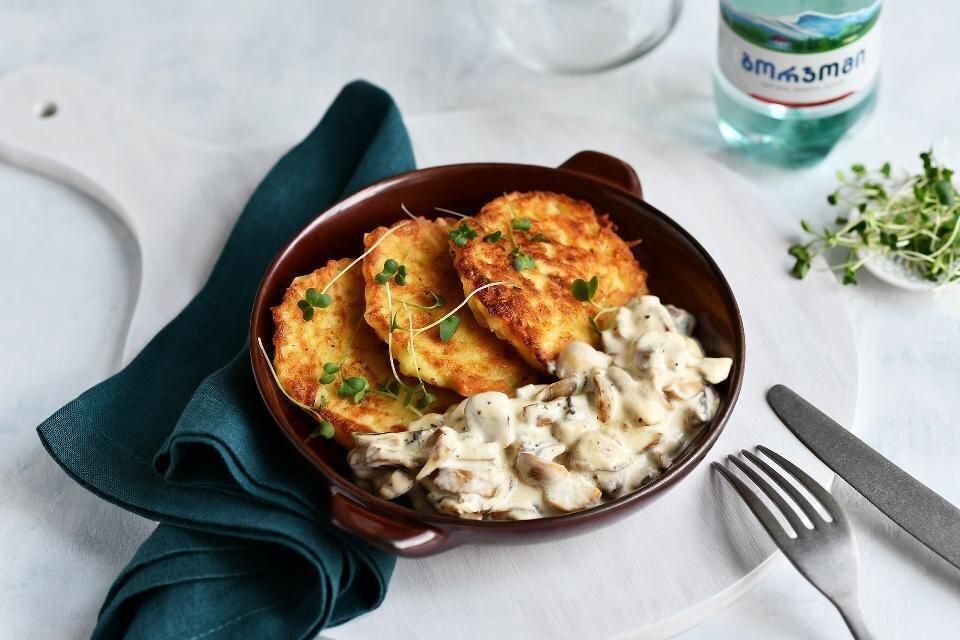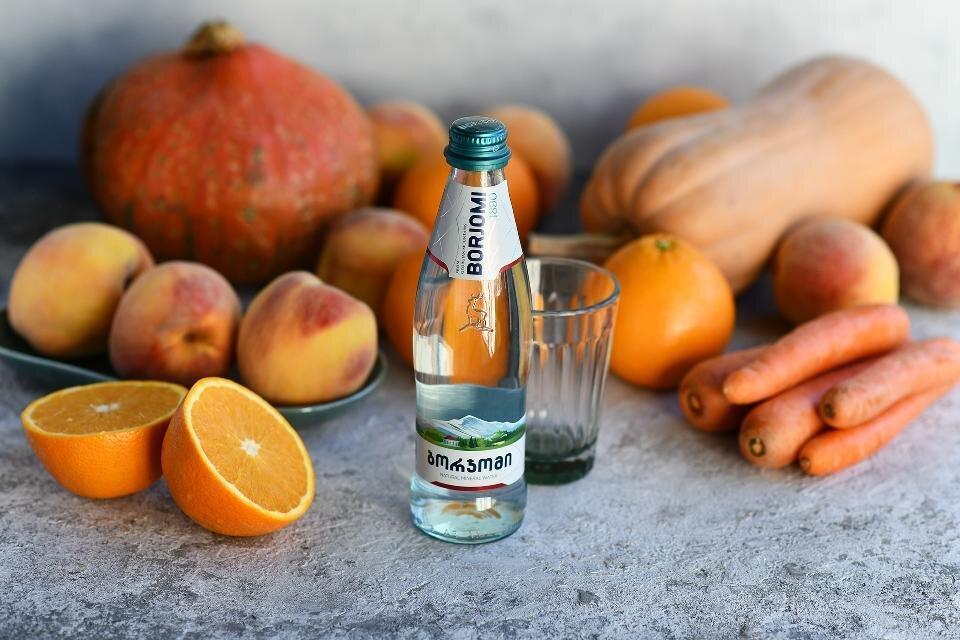Latest blogs
See All
MESSAGE FROM ITALY - BEET RISOTTO
This time the tour guide will take you to Italy, our host is Nana Zuriashvili, the author of the culinary page buongustaio (gourmet).
“I have been living in Italy since 2013, namely, outside the city of Naples, in the small historic town of Pozzuoli. Pozzuoli is built on an active volcano. I know it sounds quite dangerous, but the place is of unusual beauty. I have been married for 6 years and I have three daughters. So far my career advancement is stopped, but I plan to study architecture from next year. I discovered a great affection for cooking in Italy. I became fond of Italian cuisine. Since I had so much free time, I was studying and making experiments. I think I am a good cook today and I am going to deepen my culinary skills in the nearest future.
Naples has a very long history, both culinary and musical. For those who do not know, the first opera house “San Carlo” was built in Naples and the first pizza was baked. Naples is unique for its noisy and narrow streets, large piazzas, multiple and delicious pizzerias, the best espresso, mozzarella and much more to list. It is the county of “O sole mio” and many more historical songs.
As this region has sea and sun, people are very joyful, fiery and emotional, somehow they resemble us, Georgians. In my family, regardless of age, everyone loves pasta .. I often cook new pasta and my children often help me with cooking it ... I think that cooking is one of the types of art and it must be necessarily shared, especially at a young age, when they get to know the world ... I think the more things they touch on from childhood, the more imagination and ideas they develop. In general, I like to cook, I always cook and do something, more cereals, less sweet ... but I would say, nothing can be compared to Italian gastronomy.
Italians have hourly meals. Colazione – sweet for breakfast, pranzo- definitely pasta for lunch and then another dish, a glass of wine and finally fruit and dessert. They eat more cereals in the evening. Risotto or soups ... they attach great importance to quality and proper nutrition. My husband loves Georgian cuisine, especially Khachapuri, Georgian cheese and “Dedas bread”. He misses it the most...
The dish that I will share with the readers of Gastro Guide is a kind of experiment that I prepare for friends and family in general ... Beetroot is not very popular in Italy, so I decided to introduce its taste to friends so that they would not forget it and I had a success actually.
For beet risotto you will need:
300 g rice arborio
400 g beets
100 g Gorgonzola (blue cheese)
30 g walnuts
20 g butter
A little olive oil
Vegetable broth
Salt
Pepper
Preparation:
First prepare the vegetable broth. Put onions, carrots, potatoes, tomatoes, celery in a saucepan and cook for 20 minutes. Peel beets and then grate them.
Put one tablespoon of butter in a separate wide and low saucepan, and when melted, add rice. Let stand for 2 minutes and add the beets, stir for 1 minute and then add the vegetable broth so that it comes out on top. Boil for 15-16 minutes (read the label during cooking) and add the vegetable broth from time to time.
The mass should not be juicy, it should have a creamy texture. Remove from the heat, add gorgonzola and salt, stir well. Transfer onto a plate and garnish with finely chopped walnuts, gorgonzoli and pepper.
Buon appetito!”
15 March, 2024

The legend of the Georgian "Supra"
Georgia, a small yet exceptional country, boasts a remarkable natural diversity. The nation is renowned for its varied landscapes, including mountains, forests, a rich array of flora and fauna, mineral-rich thermal waters, and mud deposits. Georgia enjoys a temperate climate with distinct regional weather patterns, encompassing Black Sea subtropical, dry continental, and even alpine climates.
The fertile Georgian soil provides an abundance of seasonal fruits and vegetables, alongside wholesome and delectable dairy products, and a profusion of aromatic spices. The artful blending of these exceptional ingredients results in a harmonious symphony of flavors. But how did this culinary journey begin? It began with the playful exploration of diverse ingredients and flavors.
In the modern world, people often take for granted the convenience of acquiring their desired food without much thought or gratitude. A trip to the supermarket, dining at a restaurant, or ordering a meal with the push of a button has become commonplace. However, it's worth contemplating how we arrived at this point.
Initially, humans consumed raw food, adopting a hunter-gatherer lifestyle. Eventually, they discovered that cooking food over fire improved taste and safety. Over time, they transitioned to agriculture, cultivating various crops and developing culinary skills. They experimented with ingredients, flavors, and cooking techniques, creating an intricate culinary tapestry. The evolution of cooking involved extensive trial and error, resulting in both an art and a science.
The culinary heritage of Georgia, a country steeped in history, is also shaped by its strategic location as a crossroads for trade routes, including the historic Silk Road connecting Europe and Asia. This positioning has contributed to the richness of Georgian spices, seasonings, and cooking methods.
In Georgian culture, dining is more than sustenance; it's a ritual and a sacred act of sharing. Bread, often referred to as the "burji"(Pier) of the Georgian table, holds a special place in this tradition. The act of breaking bread and sharing it with others signifies a profound connection. Each region of Georgia has its unique bread, and the scent of freshly baked bread could travel from one village to another.
Khachapuri, a symbol of celebration and joy, is a highlight of Georgian cuisine. Variations like Imeruli, Adjarian, Meghrul, Ossetian, and Tushurian Kotor khachapuri showcase the culinary diversity. What makes khachapuri exceptional is not just its simplicity, composed of two main ingredients, but the soul and heart infused by the cook. The choice of song sung while kneading the dough can significantly influence the outcome.
While the word "bread" exists in various cultures, Khachapuri has a distinct European touch, earning it the moniker of "Georgian pizza." Nevertheless, its roots can be traced back to Asian influences, with distant relatives in Tibet, China, Nepal, and Mongolia. Khinkali, another Georgian culinary gem, is more than a dish; it's an experience. It has its own set of rules and requires an intimate connection between the diner and the dumpling.
As the demand for vegetarian cuisine grows worldwide, Georgia's bountiful gardens offer a wealth of options, from spinach and beets to cabbage, eggplant, carrots, beans, thistles, leeks, and an array of nuts and spices. This blend results in a delightful explosion of flavors, meeting the modern world's culinary challenges.
Georgian cuisine is a treasure trove of diverse dishes that vary by region. Svani kubdar, Rachuli lobiani, Meguri kharcho, Elarji, Guruli pie, and an array of cheeses like Sulguni, Imeruli, Tenil, and Gudi are just a few examples of this culinary diversity. It's no wonder that Georgian cuisine captivates the hearts of all who savor it. Visitors often rank Georgian food among their favorite aspects of the country.
Recently, Georgian cuisine has gained international recognition, with dishes like khachapuri earning spots on lists of the world's top 100 dishes. The essence of Georgian cooking lies in its connection to the land, as Georgia is primarily an agricultural nation. This deep connection is reflected in the dedication to preserving culinary traditions that have been passed down through generations, ensuring that timeless recipes remain unchanged.
Despite its rich historical roots, Georgian cuisine continues to evolve. Leading local restaurants offer modern interpretations of traditional dishes, demonstrating that Georgian cuisine is a dynamic entity that adapts to the times while preserving its enduring traditions. This culinary journey represents a blend of heritage and innovation, and the beloved Borjomi Buddha serves as a worthy member of the Georgian table in this fascinating adventure.
08 November, 2023

5 PRODUCTS TO FACE WINTER
Along with cooling, our skin needs specific care, in addition to external care products, it is important to get the necessary vitamins and minerals for the health and youth of our skin with food as well.
These five products help us to improve the condition of the skin after the scorching summer sun rays and also to face the cold days of winter well prepared.
Apples are a strong anti-inflammatory remedy, the old English adage - one apple a day, keep the doctor away, is not excessive at all. Apples are full of fiber, so it's important to eat apples but not drink them in juice form so we don't lose precious fiber, which is the basis of a healthy digestive system.
The skin of an apple contains a pigment that neutralizes the damage caused by ultraviolet rays to the human skin, and the nutrients in it are involved in the formation of melanin which protects our skin from the sun rays.
One apple a day is an immunity booster because of the vitamin C it contains, which is so important in the pre-winter period, during the virus season.
The history of the use of ginger for culinary and medical purposes goes back many centuries.
Ginger has strong anti-inflammatory properties that is why in combination with lemon and honey it is such a relief during colds. At the same time, it is rich in antioxidants, which are necessary for improving the condition of the skin and preventing a number of diseases.
Ginger accelerates blood circulation and the process of cell replacement, distributes nutrients throughout the body, helps eliminate toxins, which is a prerequisite for healthy and well-cared skin.
Kale is a “superfood” and is considered the healthiest vegetable. This type of cabbage, rich in vitamin K, participates in many beneficial processes, has anti-inflammatory properties, and also contains carotenoids, which naturally protect our skin from the effects of ultraviolet rays, thus slowing down the aging process of the skin.
Walnut is a vegetable product rich in Omega 3. 1 handful of walnuts a day helps us maintain smooth skin, improves blood circulation, which is a necessary condition for the equal distribution of nutrients in the body, protects the skin from ultraviolet radiation and heals skin damaged by the sun.
Oranges and lemons are a source of vitamin C, which, along with strengthening the immune system, participates in the formation of collagen, and the elasticity of our skin depends on collagen. 1 glass of citrus juice contains a daily dose of vitamin C.
15 August, 2023

MESSAGE FROM UKRAINE – DERUNY
“Hello dear reader of Gastro Guide! I’m Irakli Beridze, originally from Adjara. I was born and raised nine kilometers away from Batumi, in the village Tsikareuli, Ortabatumi community. I graduated from Nikoloz Baratashvili Boarding School of Advanced Physics and Mathematics in Salibauri, where I went after early death of my mother. In my case it was a successful decision made by my father as I spent positive months and met lots of valuable people there.
Then I went to the Pedagogical College and Batumi Maritime Academy, Faculty of “Navigation of Maritime Roads”. I worked on various types of merchant vessels, thanks to which I became acquainted with the port cities of thirty countries, local people and their mode of life, including culinary and customs. Probably that is why I am so communicative and conflict-free, in which my knowledge of foreign languages - Russian and English - helped me.
When I was promoted to the rank of Captain’s assistant, one of challenges influenced my decision to change my profession. You will probably ask whether I miss the sea and ship?! Certainly, yes, but I have found myself in another field now and I want to devote my efforts to its development and refinement, learn and teach.
On November 15, 2014, after my friend told me “Let’s start our business”, I arrived in Ukraine, in Lviv with beautiful architecture and history, which is even referred to as the cultural capital of this country.
Here I met and married Oksy Wozniak, Ukrainian chef, brand chef and food photographer. Three years later, on November 15, we had a daughter, Nicole. We are currently rebranding restaurants with different concepts, at the same time we are working in the positions of brand chef and chef in the restaurant of French and Italian cuisine “Baguette”.
In which region do you live? Tell us about traditional and distinctive dishes of this region.
The region where I live is called Galichina, it represents an excellent example of the historical and cultural heritage of Austria, Czech Republic, Poland, Moldova, Romania and Hungary on the territory of western Ukraine. This is due to the fact that these countries bordered on the country in many cases, have been carrying out expansion on this territory.
Lviv Oblast is an important part of Galicia, it is about the same size as Georgia. The main culinary direction is Galician, i.e. it unites the best cuisines of the countries that still border North-Western Ukraine.
Probably few people in Georgia know that besides lard, borshch and vareniki, Ukrainian cuisine is rich with many other interesting dishes. Each region has its own dishes due to its peculiarities, including a very interesting place is occupied by Galician region.
Nowhere do they bake such fragrant and delicious Austrian strudels with different ice creams and vanilla lemon sauces as here.
The pride of proud Carpathian mountains “banusz” with sheep brynza, dried and raw white mushrooms and roasted ham is not inferior to Georgian Ghomi with cheese. Pork ribs stewed in a tandem of young beets and cherries in beet kvass, the so-called “Spundra” is a celebration of tastes.
Four meats “Bograch” and chicken “Paprikash” with goulash will tell you the story of Transcarpathia while eating them. Exquisite Czech potato dumplings with egg whites and cabbage pickle “Bigos” with smoked plum sauce with beef roll is a gastronomic bliss! Here are the dishes “a kind for” the poor and “by the way” for the rich, Ukrainian Deruny with minced meat and mushroom sauce and Polish soup, rescuer from hangover “żurek”, sorrel green borscht and cabbage pickle and pork "Kapusniak", wide range of sausages, especially sausage made from “Drogobych” minced meat and “Krovianka” with buckwheat filling, shin marinated in beer and apple pickle “Мочені яблука”. The culmination is a dessert however, a unique alliance of the famous Lviv cheese “Sirnik”, dried apricots and chocolate.
Which dishes do you prepare for the family more often?
At the age of nine, my mother passed away giving me a birth, due to doctors or her negligence. We were seven children in the family, my father worked, and I had to take care of the little ones, I really liked cooking, I often helped my mother and grandmother. I asked them questions and mastered cooking this way. I had a different vision from the beginning and I never hid it from anyone. Even now, when I have my own family, I try to provide them with healthy and useful food, I give preference Pkhaleuli from Georgian cuisine.
If I cook meat I definitely prefer baked or steamed meat. Chakapuli and Khinkali, Adjarian Khachapuri on buckwheat flour and salads with pressed Matsoni orange cedar sauces. I often make Adjarian Pkhalobia cooked on beef broth with yellow corn flour Mchadi. Three-year-old Nicole is celebrating then shouting “I want Chadi, Chadi”.
Who is your source of culinary inspiration?
Probably my grandmother and the uniquely bitter or sweet years spent with her in the village, as well as childhood memories. In fact, she raised me and my sisters and brothers. She cooked amazingly delicious food, “Neni this is due to Imeretian blood” she used to say. She mostly cooked in the fireplace, on a firewood emitting smoke, over a slow fire. She used cherry or pear wood firewood for meat dishes, barley or blueberry firewood when baking beans, Khachapuri or Machadi. Their specific and aromatic smoke added a special touch to the dish prepared in a copper kiln or cast iron pan. She used to wrap garlic in a bunch of corn with various spices and boil. She called it “Gakochili”, in modern language it is a sous vide technology.
Please tell us about your future plans.
I am thinking of establishing myself in Georgia in the future. I would like to make ,y contribution in the popularization of Georgian cuisine, presenting it not only as a gastronomy, but also as a Georgian cultural heritage.
Any chef thinks about opening his or her own restaurant. I only have some general outlines in this regard, my plans are based more on ethno concept. I think the right theme and a team of professionals should create a product that will not only attract foreign guests, but also the local customer will feel happy to visit it all year round and get unforgettable emotions.
The dish we have chosen for the gastronomic guide readers is easy to make and is much liked by big or small ones.
The history of the origin of Deruny is attributed to the proximity of Ukraine to Belarus, due to its resemblance to the Belarusian Draniks. In Belarus it was spread from Germany in its turn, although Ukrainian cuisine had no lack of dishes prepared with potatoes.
Deruny has its name in different parts of the world: Plyatsky, Kliotsky, Kartoplianki, Tertzi, and many other names evidences the fact that it is a dish created independently of the Germans. The full version of its preparation was first published in Jana Schitler’s culinary book in 1832, and the recipe included a mass of finely or coarsely grated potatoes and flour made in pork fat “Smalec”. It has undergone certain transformation over time and other ingredients have been added to it.
Deruny gained universal recognition in the 1930s, when “Holodomor” was raging in the country. Today millions of kilograms of Deruny are made in Ukraine, with lots of sauces or stuffing. There is also a Deruny Festival, where chefs invited from all over the country compete with each other to make a budget, creative and delicious Deruny. 70% of the two million tourists who come to Lviv consider Deruny to be the best dinner, just like my family.
Deruny with mushroom sauce
Ingredients: (per 1 kg mass)
730 g peeled potatoes
50 g bread flour
4 eggs
200 g onions
5 g salt
1 g black pepper
50 g sour cream
Peel off the potatoes, remove the starch as much as possible and add sour cream so that the mass does not get black. Then add the finely chopped onion and the rest of the ingredients. Pour oil on a well-heated pan and put the mass with a tablespoon, cook over medium heat, on both sides, until crispy. We can fry both small and whole ones, put in the stuffing that we want and then fold it.
Cover the surface of the remaining mass with flour and seal it. It is desirable to keep it for no more than two hours. Before use, remove the flour cover and fry. It is usually eaten with sour cream, but is also served with mushroom and cream sauces.
You can also prepare meat Deruny. Put the desired minced meat in the center of the mass poured on the pan and pour the same mass and flatten the surface.
Mushroom and cream sauce:
100 g finely chopped onion
2 cloves of garlic
50 g oil
Thyme one pack
200 g mushrooms
100 g cream
Pepper and salt to taste
We squeeze the garlic into small pieces, fry thyme and onion into the hot oil. When onions are stewed, remove garlic and thyme, add medium-sized mushrooms. As soon as the mushrooms are stewed, add pepper and salt, finally cream, bring to a boil and set aside. Blend if desired.
Enjoy.
15 August, 2023
Frequently viewed blogs



